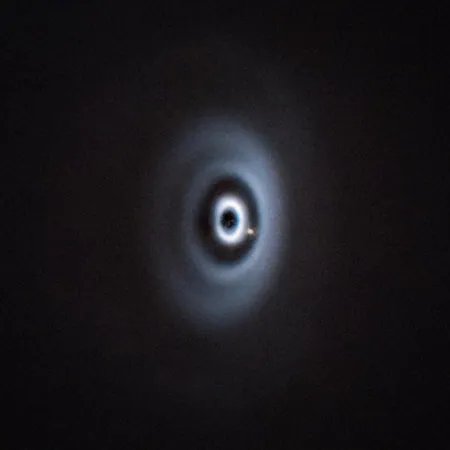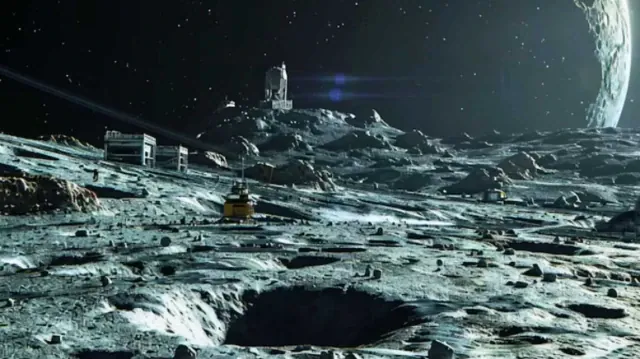
Astronomers Discover Newborn Planet that Could Change Everything We Know About Planet Formation!
2025-08-27
Author: Noah
Revolutionary Discovery: A Glimpse into Planet Formation
In a groundbreaking revelation, astronomers have found a baby planet that could reshape our understanding of how planets form. A team of international researchers, led by scientists at the University of Galway, has identified a massive, newly-formed planet orbiting a star that closely mirrors the young Sun.
This exciting new world, dubbed WISPIT 2b, is a mere five million years old—just a blink of an eye in astronomical terms, especially when compared to our ancient Earth, which is about 4.5 billion years old. Researchers believe that WISPIT 2b is a gas giant, comparable in size to Jupiter.
Cutting-Edge Technology Brings WISPIT 2b into Focus
The identification of this celestial body was made possible by the European Southern Observatory’s Very Large Telescope (VLT) stationed in the breathtaking Atacama Desert of Chile. This cutting-edge facility enabled researchers to capture the planet illuminated by near-infrared light, revealing its heat signature from its formation.
Dr. Christian Ginski, from the School of Natural Sciences at the University of Galway, shared insights about their discovery: "We took short observations of many young stars to see if we could spot a faint dot of light—indicative of a planet—next to them. In this case, however, we stumbled upon a stunning, unexpected multi-ringed dust disk."
Upon spotting this mesmerizing multi-ringed disk, Ginski’s team swiftly requested further observations to confirm the presence of a planet. This remarkable find is only the second confirmed instance of a planet being discovered at such an early stage of evolution around a star resembling our Sun.
WISPIT 2b: The First Clear Example in a Dust Disk!
Notably, WISPIT 2b is the first unequivocal example of a planet existing within a multi-ringed disk of dust and gas, providing a unique opportunity to study how nascent planets interact with their formative environment.
Evidence of Atmosphere Formation
In a significant confirmation, researchers from the University of Arizona utilized specialized instruments to detect WISPIT 2b in visible light as well. This detection suggests that the planet is actively accumulating gas, indicative of an atmosphere in the making.
This discovery highlights that astronomers have captured WISPIT 2b during a pivotal growth phase—offering them a unique front-row seat to processes that shape not only our own Solar System but potentially countless other planetary systems throughout the galaxy.
Inside the Cosmic Cradle of Planet Formation
WISPIT 2b is nestled within an expansive protoplanetary disk encircling its host star. These swirling disks, composed of gas and dust, are the prime nurseries for planetary life. The disk surrounding WISPIT 2b stretches an astounding radius of 380 astronomical units—about 380 times the distance from Earth to the Sun.
Such disks often boast stunning features like rings and spiral arms, believed to be sculpted by forming planets themselves. Observing these structures in real time significantly enhances researchers' understanding of the evolutionary journey of planetary systems.
A New Frontier in Astronomy
For astronomers, WISPIT 2b is far more than just another exoplanet. It serves as a vivid snapshot of the planet formation process, bridging the gap between theoretical models and observable realities. With continuous advancements in technology, researchers remain optimistic about uncovering why planetary systems—including our own—exhibit such extraordinary diversity.
This astonishing discovery has already captivated the scientific community and is expected to pave the way for years of follow-up studies that could redefine our comprehension of how planets are born and evolve.









 Brasil (PT)
Brasil (PT)
 Canada (EN)
Canada (EN)
 Chile (ES)
Chile (ES)
 Česko (CS)
Česko (CS)
 대한민국 (KO)
대한민국 (KO)
 España (ES)
España (ES)
 France (FR)
France (FR)
 Hong Kong (EN)
Hong Kong (EN)
 Italia (IT)
Italia (IT)
 日本 (JA)
日本 (JA)
 Magyarország (HU)
Magyarország (HU)
 Norge (NO)
Norge (NO)
 Polska (PL)
Polska (PL)
 Schweiz (DE)
Schweiz (DE)
 Singapore (EN)
Singapore (EN)
 Sverige (SV)
Sverige (SV)
 Suomi (FI)
Suomi (FI)
 Türkiye (TR)
Türkiye (TR)
 الإمارات العربية المتحدة (AR)
الإمارات العربية المتحدة (AR)